 In the ever-evolving landscape of modern warfare, the ability to excel in Close Quarters Combat (CQC) is a defining attribute of elite military units. Air Force Special Forces, including the Combat Control Teams (CCT) and Special Air Force Rescue Teams (SART), undergo some of the most rigorous and comprehensive CQC training regimens to prepare for high-stakes missions. This article delves into the intricacies of their training programs, shedding light on how these warriors achieve unparalleled proficiency in close-quarters engagements.
In the ever-evolving landscape of modern warfare, the ability to excel in Close Quarters Combat (CQC) is a defining attribute of elite military units. Air Force Special Forces, including the Combat Control Teams (CCT) and Special Air Force Rescue Teams (SART), undergo some of the most rigorous and comprehensive CQC training regimens to prepare for high-stakes missions. This article delves into the intricacies of their training programs, shedding light on how these warriors achieve unparalleled proficiency in close-quarters engagements.
Close Quarters Combat (CQC) refers to the tactical concept of engaging adversaries at very short ranges, typically within confined spaces. Mastery of CQC is vital for Air Force Special Forces, as it enables them to operate effectively in environments where split-second decisions and precise actions are crucial. Their training encompasses a wide array of scenarios, ensuring they are prepared for any situation that demands close-quarters engagement.

The Role of Air Force Special Forces in Modern Warfare
Air Force Special Forces units, such as the CCT and SART, play pivotal roles in contemporary military operations. The Combat Control Teams (CCT) are tasked with conducting missions that require them to infiltrate hostile territories to establish assault zones, provide air traffic control, and coordinate air support. Their expertise ensures that air operations are executed seamlessly, even in the most challenging environments. citeturn0search5
Similarly, the Special Air Force Rescue Teams (SART) are dedicated to personnel recovery missions, often venturing into hostile areas to rescue downed pilots or other isolated personnel. Their motto, “That Others May Live,” epitomizes their commitment to saving lives, regardless of the risks involved. citeturn0search0

Core Components of CQC Training
The foundation of CQC training for Air Force Special Forces is built upon several core components:
- Hand-to-Hand Combat: Developing proficiency in unarmed combat techniques to neutralize threats when weapons are not an option.
- Firearms Training: Mastering the use of sidearms and rifles in confined spaces to ensure quick and accurate target engagement.
- Room Clearing Techniques: Learning systematic methods to enter and secure rooms, minimizing exposure to potential threats.
- Stress Inoculation: Training under simulated combat stress to enhance decision-making and performance under pressure.
These elements are integrated into a cohesive training program that emphasizes adaptability, precision, and resilience.

Specialized Training Facilities and Simulations
To replicate the complexities of real-world scenarios, Air Force Special Forces utilize specialized training facilities equipped with modular shoot houses, live-fire ranges, and urban warfare simulators. These environments allow operators to practice CQC techniques in settings that closely resemble operational conditions, enhancing their readiness for actual missions.
For instance, during urban warfare simulations, operators navigate through mock villages or buildings, encountering role-players acting as adversaries or civilians. This immersive training hones their ability to make rapid decisions, distinguish between combatants and non-combatants, and execute missions with precision.

Physical and Mental Conditioning
CQC demands exceptional physical fitness and mental fortitude. Operators undergo intensive physical conditioning programs designed to enhance strength, endurance, agility, and flexibility. This physical preparedness ensures they can perform demanding tasks, such as breaching obstacles or engaging in hand-to-hand combat, without succumbing to fatigue.
Equally important is mental conditioning. Training includes stress inoculation exercises, where operators are exposed to high-pressure situations to develop composure and decision-making skills under duress. Techniques such as controlled breathing, visualization, and scenario-based drills are employed to cultivate mental resilience.

Integration of Technology in Training
Modern CQC training incorporates advanced technologies to augment traditional methods. Virtual reality (VR) and augmented reality (AR) systems provide immersive training experiences, allowing operators to engage in simulated combat scenarios that are both realistic and adaptable. These technologies offer the advantage of repetitive practice without the logistical constraints of physical training environments.
For example, VR simulations can recreate complex urban settings, enabling operators to practice room clearing and hostage rescue missions with varying levels of difficulty. This technological integration enhances their tactical proficiency and adaptability.

Continuous Evaluation and Adaptation
The dynamic nature of warfare necessitates continuous evaluation and adaptation of training protocols. Air Force Special Forces regularly assess their CQC training programs to incorporate lessons learned from recent operations, emerging threats, and advancements in tactics. This iterative process ensures that operators remain at the forefront of c
*Capturing unauthorized images is prohibited*


